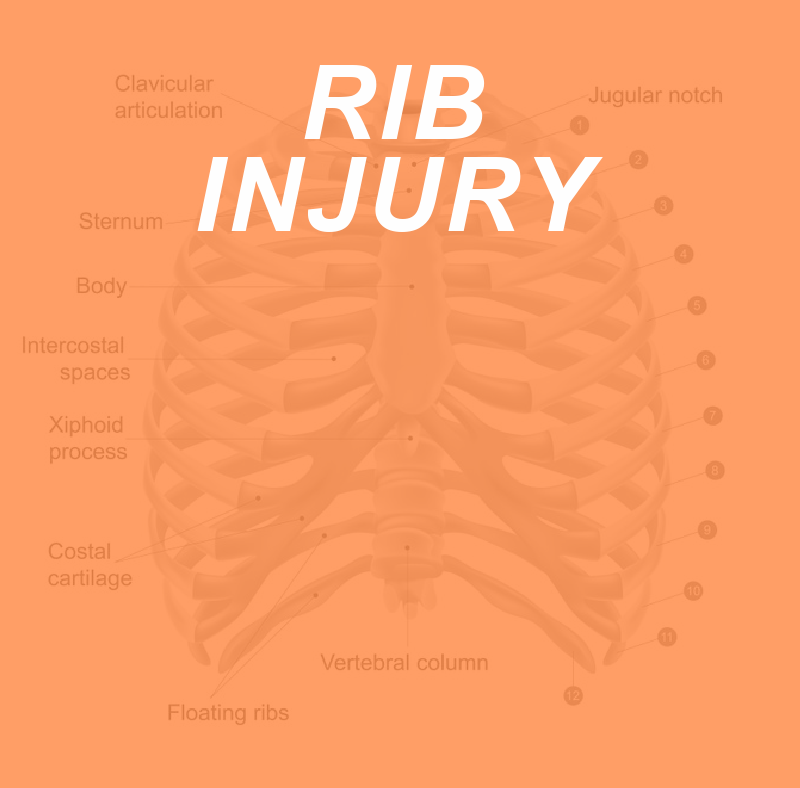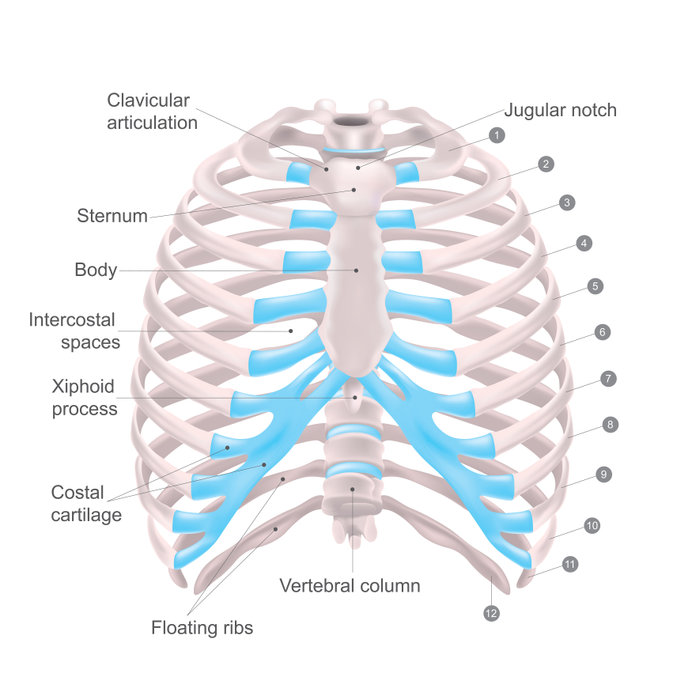
Anyone who engages in combat sport training is bound to get a few bumps and bruises. Rib injury is quite common and personal trainers can help their combat and martial arts clients handle them with more ease. The following describes the anatomy of the rib cage, injury type to the rib cage that may occur from combat sports; and, the healing process to the injury.
Rib Anatomy
Each rib is a curved flattened bone that is the wall of the thorax. Ribs have two articular facets separated by a wedge of bone. Ribs articulate posteriorly with T1-T12 vertebra by the pedicle (superior costal facet) and the vertebra above (inferior costal facet). The rib anterior attachment is via hyaline costal cartilage to the sternum. (1)

The ribs attached to the sternum are classified into three groups: true, false, and floating ribs.
True ribs articulate directly to the sternum with their hyaline costal cartilage (ribs 1-7).
The false ribs indirectly articulate to the sternum as their costal cartilage attaches to the seventh costal cartilage, by the costochondral joint (8th, 9th, and 10th ribs).
Two ribs, 11th and 12th, do not articulate to the sternum, they are the distal two ribs, called the floating ribs.
Intercostal muscles are attached to the periosteum of the rib above and to the rib below. The intercostal muscles allow the rib cage to expand and contract during breathing. Breathing also involves the diaphragm, which is a muscular partition separating the thorax from the abdomen.
“Upon inhalation, the diaphragm contracts and flattens and the chest cavity enlarges. This contraction creates a vacuum, which pulls air into the lungs. Upon exhalation, the diaphragm relaxes and returns to a dome-like shape and the air is forced out of the lungs.”(3)
Rib Injury
Martial Arts Kumite can employ a roundhouse kick and/or punches that strike and injure the ribs. For example, ‘fight science’, Mixed Martial Arts (MMA) fighter, Bas Rutten demonstrates how a spleen injury occurs by performing a powerful punch on the upper left side of the rib cage.
Rib injury can include a strain of the intercostal muscle, a fractured rib, or costal cartilage damage. A trained professional must access the injury. Immediate discoloration of the rib area after a strike implies a strain of the intercostal muscle. However, the injury may also include a damaged rib.
An X-ray may be required to confirm a rib fracture, whereas an MRI is ordered for soft tissue assessment. Damaged cartilage can be accessed when the area is palpated and a crunching sound is heard. CT scans or ultrasound may be used to differentiate a costochondral separation from a rib fracture. [Note: cartilage injury is not the same as costochondritis, an inflammatory condition causing sharp pains or aches on either side of the sternum.]
An intercostal strain is an over-stretched muscle fiber. The pain severity between an over-stretched muscle and a tear is differentiated by the injured individual still being able to twist and stretch with a strain. The tear, however, is very sensitive to the touch and sharp pain occurs when taking a deep breath, coughing, or sneezing. A surgical procedure may be needed when half or more of the intercostal muscle is torn. The tear is evidenced by a large intravascular hematoma. Aside from the tear or strain a bruised or broken rib causes pain that continues to grow worse, accompanied by trouble breathing and shortness of breath.
Healing Process for Rib Injury
Proper healing of the injury requires assessment by a health professional.
The strain usually heals within three to six weeks. The tear is more complicated, especially if surgical repair is needed. Both involve an inflammatory process, leading to swelling. The most common therapy is NSAIDS (Non-Steroidal Anti-Inflammatory Drugs) to minimize pain and swelling. Healing of the injured rib can also require a compression bandage. The fractured rib can take a minimum of six to eight weeks to heal.
In addition to rest and NSAIDS, it is important to have movement of the blood in the injured rib area. A technique I favor known as therapeutic contrasting includes one-minute ice, followed by one-minute heat for seven cycles adding up to 14 minutes, performed two to three times a day. The cold/hot cycle helps rid stagnant blood from the injured area and reduces inflammation.
During the healing of the intercostal muscle strain and/or tear scar tissue, i.e., fibrotic tissue forms, impairing muscle function. The fibrotic tissue requires stretching; and, if not done before becoming active again may cause the muscle to snap. Stretching increases blood flow helping the fibers to heal faster.
A treatment approach for costochondritis can include the ‘doorway stretch’. The stretch is performed by positioning one’s self in a doorway with one hand, e.g. right hand on the door frame in one of three positions: above the head, at shoulder level; and, at the floating rib level.
Once the right hand is in position on the door frame, then lean/rotate toward the left, keeping the feet stationary, until a comfortable stretch is felt in the back area of the chest. Repeat this stretch with the left hand, leaning/rotating the body to the right, keeping feet stationary. Stretches are performed with each hand position on the door frame.
Modalities for the Rib/Intercostal Muscle Healing Process
Two additional modalities that have facilitated injury healing include Magnetic Therapy and Essential Oil Therapy, both requiring professional oversight.
Magnetic Therapy for Torn/Strained Muscles
Magnets will cause capillaries to relax, allowing increased blood and oxygenation into the area, and reduction of the pain-producing prostaglandins. In theory, muscle spasms are minimized and pain reduced.
Research by Meline N.L. Stolting MD, Ph.D., Anne Sophie Arnold, Ph.D., et.al. [Magnetic Stimulation Supports Muscle and Nerve Regeneration After Trauma in Mice.] describes this therapy: “We found that magnetic stimulation does not cause systemic or muscle damage but improves muscle regeneration by significantly minimizing the presence of inflammatory infiltrate and formation of scars after trauma. It avoids post-traumatic muscle atrophy, induces muscle hypertrophy, and increases metabolism and turnover of muscle. It triples the expression of muscle markers and significantly improves muscle functional recovery after trauma.”
Essential Oils for Torn Muscles
Lavender oil will calm and relax the injured rib area.
Eucalyptus oil has a cooling effect on muscles while reducing pain and inflammation.
Roman and German Chamomile oils help with pain and inflammation.
Rosemary Oil reduces pain from rheumatic conditions and menstrual cramps. Its analgesic and anti-inflammatory effects are helpful for back pain.
To use any essential oil, above, place 10 to 15 drops into one ounce (or 2 tbs) of carrier oil such as: refined coconut, almond, olive, avocado, or jojoba. Do a patch test on a small area of skin to determine if irritation occurs. If no irritation after 24 hours, then use the oil by massaging into the affected area.
Summary
Combat sports can result in a fractured rib, a strained or torn intercostal muscle, and/or damaged cartilage. The severity of the injury can be evidenced by intravascular hematoma, difficulty in breathing, shortness of breath and/or sharp pain in and around the sternum. Regardless, the injury must be accessed by a professional. Soft tissue injury is accessed via MRI while fractures are accessed with X-Ray. Costochondral separation is accessed with CT scans or ultrasound.
Surgical intervention is required for a muscle that is completely torn. Support efforts of cold/hot therapy, compression bandages, and NSAIDS are recommended to increase blood flow, remove the pain-producing prostaglandins, aid in breathing and reduce inflammation and swelling, respectively. Additionally, there are modalities of magnetic therapy and essential oils to facilitate repair of muscle injury. Re-entry into training must be accompanied by stretching that allows increased blood flow to the fibrotic tissue, preventing renewed injury.
References
- Guyton and Hall Textbook of Medical Physiology, 13th ed.
- NIH, PubMed. Safarini OA, Bordoni B. Anatomy, Thorax, Ribs. 2021, Feb 7. In StatPearls, StatPearls Publishing; 2021 Jan. PMID: 30855912
- John B. West. Respiratory Physiology
- Fight Science, “television program shown on National Geographic Channel, in which scientists and martial arts masters work together to analyze the world’s fighting techniques.”
- Dr. Eric L. and Sabrina Zielinski. Essential Oil Chemistry and Safety. 2018. Eric Zielinski, D.C. Healing Power of Essential Oils. 2018. Note: Dr. Zielinski’s new book, Apothecary of Essential Oils will be released September, 2021.







